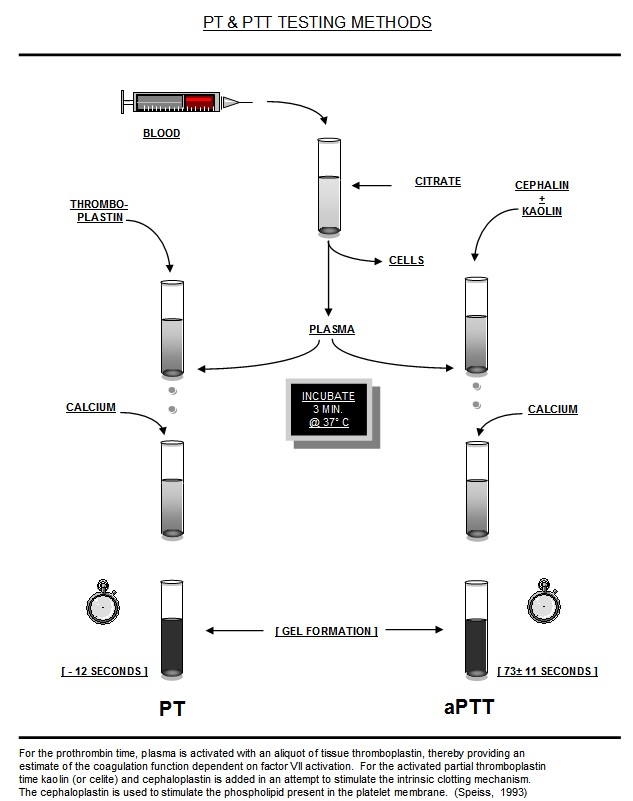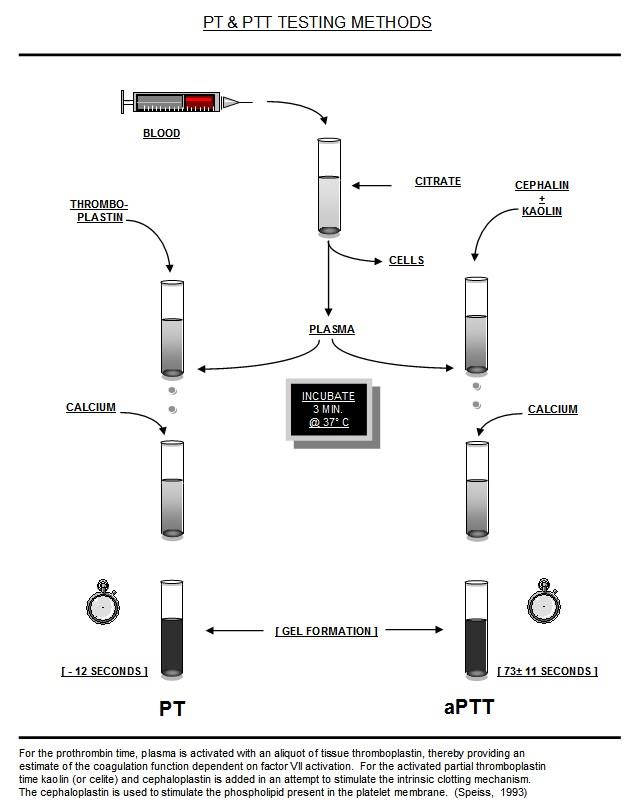Hemostasis Assays [v.1]

Partial Thromboplastin Time (Activated)
The activated partial thromboplastin time (aPTT) is test that overlaps the prothrombin time (both evaluate the common pathway), and is designed to isolate the intrinsic pathway. While these tests are similar, the aPTT utilizes kaolin or cellite and cephaloplastin to stimulate the intrinsic pathway. This pathway is the longer of the two, and this is reflected by the normal values established for coagulation to occur (approximately 24-30 seconds.
Prothrombin Time
Prothrombin time (PT), is an indicator of the concentration of prothrombin (the precursor to thrombin) in the blood. When blood is sampled from the patient, it is immediately oxalated so that prothrombin cannot be converted into thrombin (appendix H). A large influx of calcium ions and tissue thromboplastin is introduced and mixed with the oxalated blood thus nullifying the effect of the oxalate (role of calcium ions), and allowing the tissue thromboplastin to activate the conversion of prothrombin to thrombin by means of the extrinsic pathway. This provides an estimate of coagulation function that is dependent on Factor VII activation (i.e.; extrinsic pathway). The time for coagulation to occur is called the prothrombin time, and is normally around 12 seconds.
Thromboelastogram
The thromboelastogram is a whole blood clot test that was invented in the late 1940s but which has recently gained popularity because of its use in hepatic transplantation and cardiac surgery. The test is simple and essentially examines whole blood clot strength over time. The TEG assesses clot function from the time of initial clot formation through the acceleration phase, clot strengthening phase, retraction phase, until eventual lysis. In summary it examines the entire life cycle of a clot in a rather gross manner and does not isolate the subsegments of procoagulant precursors and their individual inputs into clot dynamics. It’s primary function is to examine clot strength. The two most important variables impacting on clot strength are the fibrinogen concentration and the overall platelet activity (function and number). The TEG answers four essential questions regarding clot formation:
1: Does the clot initiate in the normal time?
2: Does the clot grow normally?
3: Does it reach normal strength?
4: Does the clot hold together or does it undergo early lysis?
If the answer to all four questions is that the clot behaves normally, then there is no implication that the patient will have coagulopathic bleeding, regardless of the platelet count, Pt or aPTT. Sole reliance on the TEG as a definitive assay of platelet dysfunction should be avoided. The TEG, the platelet count, and fibrinogen concentration form a very useful battery. The TEG will detect some platelet function abnormalities. It is less sensitive to aspirin-induced platelet function changes than the bleeding time.
Reptilase Time
The reptilase time measures the interval between the addition to plasma of venom derived from a South American pit viper Bothrops jararaca and subsequent formation of fibrin. Gravlee, Davis, & Utley, (1993) discuss the test:
Since this snake venom does not require thrombin to split fibrinogen, an elevated reptilase time implicates fibrinogen rather than heparin as the cause of a prolonged thrombin time. The reptilase time is several-fold more sensitive to fibrin degradation products than even the thrombin time. (p. 449)
Sonoclot
The sonoclot is performed by placing 0.4 ml of whole blood into a cuvette in which a vertically vibrating probe is suspended. The changes in mechanical impedance exerted upon the probe by changing viscoelastic properties of the forming clot are measured on a paper tracing.
Thrombin Time
Using a Fibrometer, clotting is measured when fibrin strands bridge the gap between a stationary probe, and a moving probe, causing an increase in conductivity resulting in a timing device being halted. For measurement of thrombin time, thrombin is added to the plasma sample, and fibrin strands will form within 10 seconds if (1) functionally active fibrinogen is present, (2) heparin is absent, and (3) fibrin degradation products are absent.
Fibrin Degradation Products
The fibrin degradation products (FDP) test provides a semiquantitative determination of fragments resulting from the splitting or degradation of fibrin and/or fibrinogen. This test utilizes latex agglutination of serum and provides results either negative (≤ 10 µg/ml) or positive (≥ 10 µg/ml) of antigens which are the breakdown products of either fibrinogen or fibrin.
Hemostatometry
The hemostatometer is a recently developed tool used to assess platelet function. The process involves blood that is nonanticoagulated; being perfused through polyethelene tubing by paraffin oil displacement. This technique has been shown to cause no measurable platelet damage. Holes punched in the tubing, through which this blood drops, create a pressure drop that simulates bleeding. The pattern of pressure drops is measured from onset to pressure recovery (indicating that the holes have been repaired by method of platelet plug formation), and the subsequent outcome is a graphic depiction of a “hemostatic curve”. The area comprised within the curve represents platelet inhibition. The larger the curve, the more profound the decrease in normal platelet function.
D-dimer
The D-dimer test is a test considered more specific for detection of fibrinolysis than the fibrin degradation products test (refer to Fibrin degradation products). The D-dimer is an enzyme linked immunosorbent assay that detects and quantitates D-dimer molecules (molecules of 2 linked “D” domains) which are a specific degradation product of crosslinked fibrin. The normal D-dimer present is measured in fibrinogen equivalent units and is usually ≤ 0.5 µg/ml.




